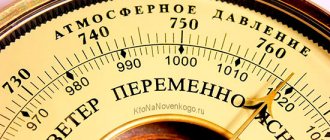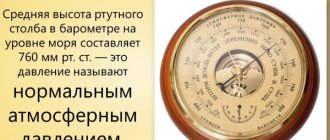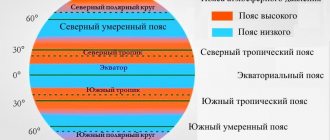Pressure (atmospheric) is a physical quantity that expresses the force with which air masses press on the earth and everything on it. For each region, the mercury column indicators are different, as they are influenced by altitude, air humidity and air temperature.
The human body adapts to the pressure values in the climate zone we live in. If there is a change in the indicator up or down (moving to another region, changing weather, traveling to the mountains), then deviations from the norm can cause disturbances in well-being.
What is atmospheric pressure?
The earth is surrounded by an atmosphere, which consists of several layers and performs protective functions (protects from harmful radiation, maintains the desired composition in the air, and also retains all living and nonliving substances on the planet by applying pressure).
To determine the value of atmospheric pressure, several units are used (mm Hg, Pascals, millibars). The essence of these indicators is to display the amount of pressure exerted by the atmosphere on a certain area of the surface. A person does not feel atmospheric pressure (at normal levels), since it is balanced by the fluid inside the body.
Millimeter of mercury
In the Russian Federation, a millimeter of mercury is approved for use as a non-systemic unit without a time limit with the field of application “medicine, meteorology, aviation navigation.” The International Organization of Legal Metrology (OIML) in its recommendations classifies the millimeter of mercury as a unit of measurement “which may be provisionally used until a date fixed by national regulations, but which should not be introduced if not in use.”
The origin of this unit is related to the method of measuring atmospheric pressure using a barometer, in which the pressure is balanced by a column of liquid. Mercury is often used as a liquid because it has a very high density (≈13,600 kg/m³), which reduces the required height of the liquid column, and low vapor pressure at room temperature.
Atmospheric pressure at sea level is approximately 760 mmHg. Standard atmospheric pressure is taken to be (exactly) 760 mm Hg, or 101,325 Pa, hence the definition of a millimeter of mercury (101,325/760 Pa). Previously, a slightly different definition was used: the pressure of a column of mercury with a height of 1 mm and a density of 13.5951⋅103 kg/m³ with a free fall acceleration of 9.806 65 m/s². The difference between these two definitions is 0.000014%.
Millimeters of mercury are used, for example, in vacuum technology, in weather reports and in measuring blood pressure. Since in vacuum technology very often pressure is measured simply in millimeters, omitting the words “mercury column”, the natural transition for vacuum engineers to microns (microns) is carried out, as a rule, also without indicating “mercury column pressure”. Accordingly, when a pressure of 25 microns is indicated on a vacuum pump, we are talking about the maximum vacuum created by this pump, measured in microns of mercury. Of course, no one uses a Torricelli pressure gauge to measure such low pressures. To measure low pressures, other instruments are used, for example, a McLeod pressure gauge (vacuum gauge).
Sometimes millimeters of water are used (1 mmHg = 13.5951 mmH2O). In the USA and Canada, the unit of measurement “inch of mercury” (symbol - inHg) is also used. 1 inHg = 3.386389 kPa at 0 °C.
Atmospheric pressure standards in different regions of Russia
The mercury pressure (the norm depends on the climate zone) varies depending on the region where the indicator is measured. A person adapts to the meaning of where he lives. Therefore, when you change your place of residence with different climatic conditions, your health often deteriorates.
Atmospheric pressure indicators in mm Hg. Art. in large regions of Russia:
| Region names | Average figures for the year | Maximum deviations |
| Izhevsky | 747 | 753 |
| Leningradsky | 755 | 762 |
| Moscow | 748 | 755 |
| Permian | 745 | 751 |
| Seaside | 755 | 766 |
| Rostovsky | 741 | 748 |
| Samara | 753 | 760 |
| Sverdlovsky | 738 | 755 |
| Tula | 747 | 755 |
| Tyumen | 771 | 775 |
| Chelyabinsk | 741 | 756 |
| Yaroslavsky | 736 | 758 |
Depending on the season of the year, the pressure indicator may change up or down.
Measuring instruments
In geography, there are 2 devices with which you can determine atmospheric pressure:
- Mercury barometer. Mainly used at weather stations, since the device is fragile and mercury is an extremely dangerous metal.
- Aneroid barometer.
A mercury barometer is a glass tube 1 meter in size. One end of this pipe is tightly sealed, and the other is lowered into a bowl that contains mercury. When the device is first turned over, liquid fills the pipe and indicates the current pressure. It would seem that mercury should completely fill the pipe, but this does not happen. The reason is precisely the air pressure. Subsequently, under the influence of this indicator, the mercury rises or falls in the flask, allowing meteorologists to talk about the current pressure in and is translated as “without liquid.” As a result, the device becomes more “dynamic” and can be safely transported to any distance. It is based on a round box from which all the air has been pumped out and which is absolutely sealed. It changes its size depending on atmospheric pressure: it expands when it increases and contracts when it decreases.
Variability of air pressure depending on the height of the relief and other conditions
When measuring pressure, the influence of the main factors should be taken into account:
- height above sea level. When located at the same point according to geographical parameters, but at different altitudes, the pressure value will change in the following directions - when rising above sea level, the pressure will decrease, and when lowering, it will increase;
- temperature indicator. When the temperature is above 0 degrees, the atmospheric pressure will decrease. At temperatures below 0 degrees, atmospheric pressure will increase;
- humidity level. Increased liquid content in the air causes increased pressure. In dry weather, the pressure indicator drops.
The article shows the norm of mercury pressure.
Therefore, in the summer at night (when the temperature drops and humidity increases), the pressure increases. The main reason for the change in indicators is the change in air density due to the influence of these parameters.
Dependence on air temperature
Air temperature is one of the key factors in the formation of atmospheric pressure. When heated, air expands, becomes denser and at the same time lighter. As a result, atmospheric pressure decreases. If we talk about cold air, then it becomes, on the contrary, heavier, increasing atmospheric pressure. Therefore, when we talk about air temperature, we need to understand that a change in this indicator simultaneously entails a change in air pressure.
To understand how this movement (primarily the replacement of air) occurs through temperatures, we can consider circulation into the premises. The air, heated by the battery, rises up to the ceiling. It stays there for some time, cools down and goes down. Then it gets back into the battery, heats up and rises again. This happens in a closed cycle.
The influence of atmospheric pressure changes on people
The human body adapts to the pressure indicator that prevails in a given climate zone. As a result, systems and organs function in a normal rhythm.
But when the value changes, a restructuring occurs in the body, which is accompanied by the following deviations:
- headaches in the temples, dizziness and fainting;
- rapid loss of strength;
- increased irritability due to headaches and fatigue;
- depression or anxiety for no reason;
- deterioration of breathing (feeling short of air);
- disturbance of the rhythm of heart contractions and pain in the heart area;
- decrease/increase in blood pressure;
- deterioration of vision and “spots” before the eyes due to increased intraocular pressure;
- impaired blood circulation, accompanied by numbness of the limbs;
- joint pain. Caused by impaired blood supply;
- nausea and loss of appetite;
- noise and buzzing in the ears;
- disruption of the gastrointestinal tract;
- deterioration of attention;
- drowsiness.
Deterioration in health is observed when atmospheric pressure changes from 5 units.
Daily fluctuations of 1-2 divisions do not affect the functioning of the body. Changes develop due to disruption of fluid movement in the body, which leads to a malfunction of all systems and a slowdown in metabolism. If these deviations in the body occur in a person even with small changes in pressure and regularly, then weather dependence is diagnosed.
Pressure distribution across belts
Considering climatic zones, we noted that they are distributed on Earth according to the belt principle. For atmospheric pressure, which, as we have already found out, also strongly correlates with air temperature, a clear zonality can also be traced on our planet. At the equator, where the sun shines most intensely, there is a belt of low pressure. From the equator, warm air moves through the winds to moderate latitudes. During this movement, the air cools and becomes heavier, sinking down. Therefore, a zone with high pressure is formed in the region of 30 latitudes.
The next zone of high atmospheric pressure forms in the area of the south and north poles. The reason is that the air temperature here is always quite low, and snow and ice also actively repel the sun’s rays. Considering the topic of winds, we said that air masses move from the poles towards the equator. Therefore, cold air, gradually moving towards the equator, becomes warmer, forming a belt of low atmospheric pressure in the region of 60 latitudes.
At-risk groups
Pressure (atmospheric) can cause problems even in healthy people if the mercury level rises or falls by more than 3 points within 1-3 hours. After the atmospheric pressure returns to normal, your health will stabilize.
The diagnosis of weather dependence is diagnosed more often in the following groups of people:
- men and women of advanced age. Their body can no longer quickly adapt to changes in atmospheric pressure;
- women during pregnancy. During this period, the body’s forces are aimed at maintaining pregnancy and developing the fetus. As a result, pregnant women feel even small pressure drops;
- children under 3-5 years old. Their body is still learning to respond to weather changes;
- teenagers during hormonal changes. During this period, the body is sensitive not only to pressure fluctuations, psycho-emotional balance is disturbed and the immune system is weakened;
- menopause period. The body again undergoes hormonal changes and is sensitive to any changes inside and outside;
- people with kidney diseases. This disease causes a violation of the water composition in the body, which causes increased sensitivity to pressure fluctuations;
- allergy sufferers and asthmatics. Weather dependence is caused by decreased immunity;
- patients with diseases of the cardiovascular system and those suffering from changes in blood pressure;
- people with chronic pathologies of the musculoskeletal system;
- patients with psychological disorders;
- people with chronic ENT diseases.
People living in big cities with poor environmental conditions are more susceptible to feeling pressure changes than residents of rural areas.
Symptoms of health problems
The mercury pressure (the norm is individual for each person) can be increased or decreased, which causes different symptoms in weather-dependent people.
Description of signs depending on changes in pressure:
| During an anticyclone. A weather phenomenon is characterized by a change from normal atmospheric pressure to increased pressure. | During a cyclone, normal atmospheric pressure changes to low. |
| Pain in the heart area | There is a lack of oxygen, accompanied by shortness of breath and the release of red blood cells (the phenomenon is dangerous due to the formation of blood clots) |
| Increased heart rate | The number of heartbeats increases, but the force of the blow decreases |
| Severe headache with sensation of pulse in temples, dizziness | Headaches may be unbearable |
| Increased fatigue and general malaise | Rapid fatigue and general weakness (feeling of “woolly legs”) |
| A rush of blood to the face, causing a feeling of heat and redness | Deterioration in quality of vision |
| An increase in blood pressure may be accompanied by nosebleeds | Feeling of noise and buzzing in the ears |
| A decrease in the number of leukocytes in the blood, which is dangerous due to colds and other infectious diseases or exacerbation of chronic pathologies | Exacerbation of joint diseases and numbness of the limbs |
| Increased sweating | Decreased blood pressure |
| Feeling of ringing in the ears | Increased intracranial pressure |
| Loss of vision sharpness | Disruption of the gastrointestinal tract, accompanied by flatulence |
| Bowel dysfunction (constipation) | The appearance of swelling of the limbs |
When pressure changes in any direction, chronic pathologies worsen.
Health Hazard
Changes in atmospheric pressure are dangerous for weather-sensitive people, as well as sudden changes (rapid diving to depth, climbing mountains, or a sharp increase/decrease in pressure) for ordinary people.
Possible complications from fluctuations in atmospheric pressure:
- disturbance of psychological balance in an irreversible direction (schizophrenia, depression, psychosis);
- development of stroke due to increased intracranial pressure;
- development of heart attack in people with heart pathologies;
- irreversible impairment of mental activity due to lack of oxygen;
- development of asthma due to impaired oxygen metabolism and bronchial activity;
- formation of blood clots with subsequent blockage of blood vessels;
- as a result of decreased immunity, infection with a dangerous infection with the development of subsequent complications;
- deterioration of the condition of blood vessels with the likelihood of developing varicose veins or their rupture;
- irreversible changes in the quality of vision and hearing. Possibly to the point of complete blindness and deafness.
Fainting is also dangerous, since the result of a fall from loss of consciousness can be fatal.
Isobaths
Isobats are used in cartography, denoting lines that connect marks that characterize equal atmospheric pressure. The definition may seem complicated, but the examples below will make everything clear. There are 2 types of such points: closed and open.
An example of a closed isobar is a cyclone. Inside such an isobath, there is low atmospheric pressure, since a large amount of precipitation falls, which forms evaporation, and also interferes with the rapid heating of the surface. As a result, an area of low pressure is formed inside, and it is surrounded by an area of high pressure.
An example of an open isobar is an anticyclone. In this case, in the center there is an area with high atmospheric pressure, and outside it there is an area with low atmospheric pressure. These situations arise when there is no precipitation inside the isobath for a long time, and the surface warms up easily and quickly. This is one of the sources of high atmospheric pressure. Such isobaths are most often found in the South Pacific or North Atlantic Ocean.
How can weather-dependent people protect themselves from pressure changes?
The mercury pressure (the normal value can suddenly change to high or low several times during the day) cannot be adjusted, so people dependent on weather conditions are advised to adhere to the following rules:
- get examined by a specialist. An examination by a doctor will reveal additional reasons for the body’s sensitivity to changes in atmospheric pressure (hidden chronic pathologies, hormonal imbalance or general weakening of the immune system);
- undergo treatment. Timely stop the exacerbation of chronic diseases under the supervision of a specialist;
- tracking weather forecasts or purchasing a home barometer. This method will allow you to prepare in advance for upcoming changes in atmospheric pressure and take preventive measures;
- ensure a good night's rest. The duration of night sleep should be at least 8 hours. It is also recommended to get up no later than 7 a.m. and go to bed before 10 a.m. Adequate sleep will allow the body to fully recover and more easily tolerate a decrease/increase in blood pressure;
- maintain a proper diet. Food should be varied and contain sufficient amounts of vitamins and minerals. Adequate nutrition will strengthen your immune system and make you less susceptible to fluctuations in atmospheric pressure. You should also exclude heavy and unhealthy foods from the menu, do not overeat before bed and do not allow long breaks between meals. This will avoid the development of pathologies in the gastrointestinal tract or exacerbation of chronic diseases that contribute to a decrease in immunity;
- Take daily walks in the fresh air (in any weather). Fresh air normalizes metabolic processes in the body, increases the amount of oxygen in the blood and helps strengthen the immune system;
- perform daily physical activity. If you have diseases that limit physical activity, a set of exercises is compiled in a physical therapy room under the supervision of a specialist. Exercises allow you to normalize the activity of the cardiovascular system, activate blood circulation and the functioning of joints. As a result, symptoms from fluctuations in atmospheric pressure will be less pronounced;
- adjust your daily routine. If possible, then during the period of the cyclone or anticyclone, postpone physical and mental work and devote more time to rest;
- take a contrast shower in the morning. The procedure allows you to normalize the condition of blood vessels, activates metabolic processes and strengthens the immune system;
- use vitamin complexes and immunomodulators. These drugs can further enhance the body’s defenses. The products are especially recommended for busy people who do not have the opportunity to take daily walks, exercise and other methods to strengthen the immune system;
- to refuse from bad habits. Nicotine and alcohol have a negative effect on blood vessels, gastrointestinal tract organs and aggravate the deterioration of the condition during changes in atmospheric pressure;
- taking medications. If you have chronic diseases, prepare the necessary medications (ointments for joint pain, tablets for headaches, or medications to lower/increase blood pressure). The type of drugs depends on the type of disease and is prescribed by a doctor;
- take sedatives. During periods of pressure fluctuations, you need to take sedative medications and drink soothing herbal decoctions. They are involved in normalizing blood pressure, eliminating nervous tension and helping to relieve symptoms from pressure changes.
Additionally (after consultation with a doctor), you can purchase in advance the following medications prescribed for increased/decreased atmospheric pressure.
| During an anticyclone | During a cyclone | ||
| To eliminate headaches | Paracetamol | Painkillers and tonics | Caffeamine |
| Analgin | Askofen | ||
| Ibuprofen | Citramon | ||
| To normalize the activity of nerve cells | Persen | To normalize blood pressure | Heptamine |
| Sedariston | Apilak | ||
| Novopassit | Dopamine | ||
| To normalize joint activity | Voltaren gel | To normalize breathing | Ketoprofen |
| Fastum gel | Intal | ||
| Nurofen gel | Cromolyn | ||
It is recommended to combine medication use with preventive measures, then changes in atmospheric pressure will not affect the general condition even in weather-sensitive people.
The normal blood pressure reading is 760 mmHg. Art. But depending on the climate zone, the value changes up or down. A person adapts to the indicator that prevails in the region of residence. It is important that a sharp increase or decrease in mercury levels is the main cause of sudden changes in blood pressure.
Author: Kotlyachkova Svetlana










